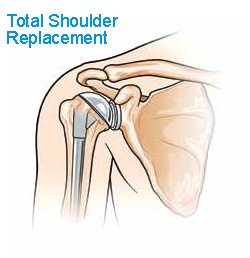

It’s the same idea as having most things fixed—worn parts are taken out, and new parts are installed in their place. In shoulder replacement surgery, the parts of the bones that rub together or have been broken are replaced with metal and plastic parts.
The part that replaces the ball consists of a partial sphere made of metal. This partial sphere sits on top of a metal stem that fits down into the shaft of the upper arm bone.
The part that replaces the socket consists of an oblong plastic disk with a cupped surface, which lines the socket and replaces the damaged cartilage. The partial sphere fits into this cupped surface to re-create the joint.
Different versions of shoulder replacement surgery are available, depending on your situation. For instance, sometimes it may be necessary to replace only the ball portion of the joint. Your surgeon will advise what is best for you.
How Will I Know If I Should Have Shoulder Replacement?
Your orthopedic surgeon will perform a very thorough examination of your shoulder. This will include a check of the muscles and tendons to determine how much strength and range of movement you have.
In addition, your surgeon will take X-rays, a CT scan (computed tomography), or an MRI (magnetic resonance imaging), which will be used to further assess the condition of your shoulder joint. If you decide on shoulder replacement surgery, these images also will be used to help your surgeon select the best type and size of shoulder implant.
Based on the examination and tests, your surgeon will determine whether you are a candidate for shoulder replacement. Although widely available, shoulder replacement is a major surgical procedure and should be considered only when all other treatment methods have failed.
What Risks Are Involved?
It’s important to understand the risks involved. There are potential complications both during and after surgery. Generally, these include infection, blood clots, pneumonia, implant loosening, and nerve damage. Your surgeon can answer your specific questions about these risks.
